AMD N2PA-LITE, N2PAP-LITE User Manual
N2PA-LITE / N2PAP-LITE
USER'S MANUAL
AMD Athlon XP/Athlon/Duron Processor M/B
NO. G03-N2PALITE1A
Release date: August 2003
Remark:
*Specifications and information contained in this manual are furnished for information use only, and are subject to change at any time without notice, and shall not be construed as a commitment by manufacturer.

TABLE OF CONTENT
USER’S NOTICE............................................................................................................ |
|
ii |
||
MANUAL REVISION INFORMATION .......................................................................... |
ii |
|||
COOLING SOLUTIONS ............................................................................................... |
ii |
|||
CHAPTER 1 INTRODUCTION OF N2PA-LITE/N2PAP-LITE MOTHERBOARD |
|
|||
1-1 |
FEATURE OF MOTHERBOARD........................................................ |
1 |
||
1-2 |
SPECIFICATION............................................................................. |
2 |
||
1-3 |
PERFORMANCE TABLE.................................................................. |
3 |
||
1-4 LAYOUT DIAGRAM & JUMPER SETTING ......................................... |
4 |
|||
CHAPTER 2 HARDWARE INSTALLATION |
|
|||
2-1 |
HARDWARE INSTALLATION STEPS ................................................ |
6 |
||
2-2 CHECKING MOTHERBOARD'S JUMPER SETTING ............................ |
6 |
|||
2-3 |
INSTALL CPU |
................................................................................ |
8 |
|
|
2-3-1 GLOSSARY........................................................................... |
8 |
||
|
2-3-2 ABOUT AMD ATHLON & DURON 462-PIN CPU ......................... |
8 |
||
2-4 |
INSTALL MEMORY ........................................................................ |
9 |
||
2-5 |
EXPANSION CARD ......................................................................... |
10 |
||
|
2-5-1 PROCEDURE FOR EXPANSION CARD INSTALLATION ............. |
10 |
||
|
2-5-2 ASSIGNING IRQ FOR EXPANSION CARD................................. |
10 |
||
|
2-5-3 INTERRUPT REQUEST TABLE FOR THIS MOTHERBOARD....... |
11 |
||
|
2-5-4 |
AGP SLOT ............................................................................ |
12 |
|
2-6 |
CONNECTORS, HEADERS ............................................................... |
12 |
||
|
2-6-1 CONNECTORS ...................................................................... |
12 |
||
|
2-6-2 HEADERS............................................................................. |
14 |
||
2-7 STARTING UP YOUR COMPUTER .................................................... |
18 |
|||
CHAPTER 3 INTRODUCING BIOS |
|
|||
3-1 |
ENTERING SETUP .......................................................................... |
19 |
||
3-2 |
GETTING HELP ............................................................................. |
19 |
||
3-3 |
THE MAIN MENU ........................................................................... |
20 |
||
3-4 |
STANDARD CMOS FEATURES ......................................................... |
21 |
||
3-5 |
ADVANCED BIOS FEATURES .......................................................... |
22 |
||
3-6 |
ADVANCED CHIPSET FEATURES .................................................... |
24 |
||
3-7 |
INTEGRATED PERIPHERALS .......................................................... |
25 |
||
|
3-7-1 |
ONCHIP IDE FUNCTION ........................................................ |
26 |
|
|
3-7-2 |
ONCHIP DEVICE FUNCTION.................................................. |
27 |
|
|
3-7-3 ONCHIP SUPER IO FUNCTION ............................................... |
27 |
||
3-8 |
POWER MANAGEMENT SETUP ....................................................... |
28 |
||
3-9 |
PNP/PCI CONFIGURATION SETUP ................................................... |
29 |
||
|
3-9-1 |
IRQ RESOURCES.................................................................. |
30 |
|
3-10 |
PC HEALTH STATUS ..................................................................... |
31 |
||
3-11 |
MISCELLANEOUS CONTROL ......................................................... |
32 |
||
3-12 |
LOAD STANDARD/OPTIMIZED DEFAULTS ...................................... |
33 |
||
3-13 |
SET SUPERVISOR/USER PASSWORD............................................... |
33 |
||
CHAPTER 4 DRIVER & FREE PROGRAM INSTALLATION |
|
|||
MAGIC INSTALL SUPPORTS WINDOWS 9X/NT/2K/XP............................... |
34 |
|||
4-1 |
NFORCE |
INSTALL NVIDIA NFORCE PACK DRIVER ..................... |
35 |
|
4-2 |
SOUND |
INSTALL ALC AC97 AUDIO CODEC DRIVER ................. |
36 |
|
4-3 |
USB 2.0 |
INSTALL NVIDIA USB 2.0 DRIVER ............................... |
37 |
|
4-4 |
PC-CILLIN INSTALL PC-CILLIN2002 ANTI-VIRUS PROGRAM .......... |
37 |
||
4-5 |
PC-HEALTH INSTALL NFORCE2 HARDWARE DOCTOR UTILITY ....... |
39 |
||
4-6 |
MAGIC BIOS INSTALL BIOS LIVE UPDATE UTILITY .......................... |
40 |
||
4-7 HOW TO UPDATE BIOS .................................................................. |
42 |
|||
i

USER’S NOTICE
COPYRIGHT OF THIS MANUAL IS RESERVED BY THE MANUFACTURER. NO PART OF THIS MANUAL, INCLUDING THE PRODUCTS AND SOFTWARE DESCRIBED IN IT MAY BE REPRODUCED, TRANSMITTED OR TRANSLATED INTO ANY LANGUAGE IN ANY FORM OR BY ANY MEANS WITHOUT WRITTEN PERMISSION OF THE MANUFACTURER.
THIS MANUAL CONTAINS ALL INFORMATION REQUIRED TO USE THE N2PA-LITE/N2PAP-LITE MOTHERBOARD. THE CONTENTS ARE SUBJECT TO CHANGE FROM TIME TO TIME WITHOUT PRIOR NOTICE. MANUFACTURER PROVIDES THIS MANUAL “AS IS” WITHOUT WARRANTY OF ANY KIND, AND WILL NOT BE LIABLE FOR ANY INDIRECT, SPECIAL, INCIDENTIAL OR CONSEQUENTIAL DAMAGES (INCLUDING DAMANGES FOR LOSS OF PROFIT, LOSS OF BUSINESS, LOSS OF USE OF DATA, INTERRUPTION OF BUSINESS AND THE LIKE).
PRODUCTS AND CORPORATE NAMES APPEARED IN THIS MANUAL MAY OR MAY NOT BE REGISTERED TRADEMARKS OR COPYRIGHTS OF THEIR RESPECTIVE COMPANIES, AND THEY ARE USED ONLY FOR IDENTIFICATION OR EXPLANATION AND TO THE OWNER’S BENEFIT, WITHOUT INTENT TO INFRINGE.
Manual Revision Information
Reversion |
Revision History |
Date |
1.0 |
First Release |
August 2003 |
Item Checklist
5N2PA-LITE/N2PAP-LITE Motherboard
5Cable for IDE/Floppy
5CD for Motherboard Utilities
□Cable for USB2 Port (Option)
5N2PA-LITE/N2PAP-LITE User’s Manual
AMD Athlon™ XP/ Athlon™/ Duron™ Processor Family
Cooling Solutions
As processor technology pushes to faster speed and higher performance, thermal management becomes increasingly crucial when building computer systems. Maintaining the proper thermal environment is key to reliable, long-term system operation. The overall goal in providing the proper thermal environment is keeping the processor below its specified maximum case temperature. Heatsinks induce improved processor heat dissipation through increased surface area and concentrated airflow from attached fans. In addition, interface materials allow effective transfers of heat from the processor to the heatsink. For optimum heat transfer, AMD recommends the use of thermal grease and mounting clips to attach the heatsink to the processor.
When selecting a thermal solution for your system, please refer to the website below for collection of heatsinks evaluated and recommended by AMD for use with AMD processors. Note, those heatsinks are recommended for maintaining the specified maximum Tcase requirement. In addition, this collection is not intended to be a comprehensive listing of all heatsinks that support AMD processors.
For vendor list of heatsink and fan, please visit
http://www1.amd.com/products/duron/thermals
http://www1.amd.com/products/athlon/thermals
ii

Chapter 1
Introduction of N2PA-LITE/N2PAP-LITE Motherboard
1-1 Features of Motherboard
The all new N2PA-LITE and N2PAP-LITE is the latest desktop motherboard solution incorporating support for the new AMD Athlon™ XP processor 3200+ with advanced 400MHz front side bus technology (FSB) and DDR400 memory modules. It brings the power and performance of NVIDIA nForce2 technology to the mainstream market with more features and functionality.
Designed with the latest NVIDIA nForce2 400 platform processors, the motherboard supports 400MHz system bus with DDR400 memory interface, a single 64-bit architecture, delivering unparalleled performance and features to the mainstream. The AGP 8X graphic interface support enables enhanced graphics performance with high bandwidth speed up to 2.12GB/s and is twice as fast as AGP 4X. To complete the integrated digital media gateway functionality, the motherboard also incorporates NVIDIA nForce2 MCP (Media and Communication Processor) with capability exceeding the traditional Southbridge connectivity to provide serial, parallel, Ultra DMA133, up to six USB 2.0 ports. Also integrated are special features such as CPU overheating protection, overclocking, and lots more. Altogether, the features on the motherboard support a broad range user experience for today’s computer market.
A special onboard CPU overheating protection circuit preventing AMD processor from being burned will automatically shutdown the power when CPU temperature is higher than the preset value, or when the CPU FAN is not working. Also built-in is the hardware monitoring function to monitor and protect your system.
The motherboard is designed to support DDR memory 2.5V voltage and AGP 1.5V voltage which can be minor-adjusted in BIOS setup. This is intended to provide user with the support of overclocking with more stable system. Also supported are adjustable CPU host clock in BIOS setup and hardware protection for BIOS against virus crash.
1

1-2 Specifications
Spec |
|
Description |
Design |
|
ATX form factor 4 layers PCB size: 30.5x19.0cm |
Chipset |
|
nVIDIA nForce2 400 System Platform Processor (400) north |
|
|
bridge |
|
nVIDIA nForce2 Media and Communications Processor |
|
|
|
(MCP) south bridge |
|
|
|
CPU Socket |
|
Support AMD Athlon 1.1GHz 1.4GHz processor |
|
Support AMD Duron 900MHz 1.3GHz processor |
|
|
Support AMD Athlon XP1500+~XP3200+ processor |
|
|
Support 200MHz/266MHz/333MHz/400MHz (Double Data |
|
|
|
Rate) Front Side Bus frequency processors |
|
Reserves support for future AMD Athlon XP processors |
|
|
|
|
Memory Socket |
|
184-pin DDR module socket x2 |
|
Support DDR266/DDR333/DDR400 DDR SDRAM |
|
|
|
Expandable to 2.0GB |
|
|
|
Expansion Slot & |
|
AGP slot x1 support AGP 3.0 & 4X/8X mode |
Headers |
|
32-bit PCI slot x5 |
Integrated IDE |
|
Two PCI IDE controllers support PCI Bus Mastering, ATA |
|
|
PIO/DMA and the ULTRA DMA 33/66/100/133 functions that |
|
|
deliver the data transfer rate up to 133 MB/s |
|
|
|
6 Channel Audio |
|
Realtek ALC 6-channel AC97’ Codec integrated support |
|
|
Front/Rear/Center-Base 6 channel Speaker |
|
Audio driver and utility included |
|
|
|
|
BIOS |
|
Award 2MBit Flash ROM |
Onboard LAN |
|
nVIDIA LAN MAC controller chip included |
(for N2PAP-LITE) |
|
Support 10/100 Mb/sec data transfer rate |
Multi I/O |
|
PS/2 keyboard and PS/2 mouse connectors |
|
Floppy disk drive connector x1 |
|
|
Parallel port x1, Serial port x2 |
|
|
USB2.0 connector x4, headers x2 (connecting cable option) |
|
|
Audio connector (Line-in, Line-out, MIC & Game Port headers) |
|
2

1-3 Performance Table
The following performance table indicates the testing results of some popular benchmark testing programs. The data provided is intended just for user reference only. You may obtain different results depending upon the hardware and software configuration used.
Performance Test Report
CPU: |
AMD Athlon XP 3000+ (FSB 166MHz) |
|||||||
DRAM: |
512MB DDR400 X1 (Winbond DDR W942508BH-5) |
|||||||
|
|
256MB DDR400 X1 (Winbond DDR W942508BH-5) |
||||||
VGA Expansion Card: ATI 9700 PRO (1024x768x32bit color) |
||||||||
Hard Disk Driver: |
IBM IC35L040AVVN07-0 (ATA-100 7200RPM) |
|||||||
BIOS: |
Award Optimal default |
|
|
|
|
|||
OS: |
Win XP Professional |
|
|
|
|
|||
|
|
|
|
|
|
|
|
|
|
|
|
|
166/166 |
166/200 |
|
||
|
3D Mark 2001SE |
|
|
12477 |
|
12291 |
|
|
|
3D Mark 2003 |
|
|
4562 |
|
4541 |
|
|
|
3D Winbench 2000 (32/32bit) |
|
393 |
|
394 |
|
||
|
PC Mark 2002 |
|
|
|
|
|
|
|
|
CPU/Memory/HDD |
|
|
6311 / 5162 / 965 |
|
6373 / 5120 / 969 |
|
|
|
Content Creation Winstone 2002 |
|
44.6 |
|
43.2 |
|
||
|
Content Creation Winstone 2003 |
|
|
|
|
|
|
|
|
Business Winstone 2002 |
|
|
36.6 |
|
34.6 |
|
|
|
Winbench 99 V1.2 : |
|
|
|
|
|
|
|
|
Business Disk Winmark99 |
|
|
10300 |
|
10300 |
|
|
|
Hi-end Disk Winmark99 |
|
|
33800 |
|
33200 |
|
|
|
Business Graphic Winmark |
|
|
752 |
|
751 |
|
|
|
Hi-end Graphic Winmark |
|
|
1830 |
|
|
1820 |
|
|
SYS Mark 2001/2002 : SISMark 2001/2002 |
Rating ( Internet Content Creation / |
|
|||||
|
Office Productivity ) |
|
|
|
|
|
|
|
|
SISMark 2001 |
|
|
245 (246 / 245) |
|
243 (244 / 243) |
|
|
|
SISMark 2002 |
|
|
|
|
|
|
|
|
SISOFT Sandra 2003 : |
|
|
|
|
|
|
|
|
Dhrystone ALU |
|
MIPS |
7800 |
|
7797 |
|
|
|
Whetstone FPU |
MFLOPS |
3137 |
|
3132 |
|
||
|
RAM Int Buffered iSSE2 |
|
MB/S |
2251 |
|
2148 |
|
|
|
RAM Float Buffered iSSE2 |
|
MB/S |
2100 |
|
2045 |
|
|
|
Integer SSE2 |
|
IT/S |
11543 |
|
11534 |
|
|
|
Floating-Point SSE2 |
|
IT/S |
12296 |
|
12282 |
|
|
|
QUAKE3 DEMO1 |
|
FPS |
239.4 |
|
228.3 |
|
|
|
DEMO2 |
|
FPS |
233.7 |
|
228.5 |
|
|
|
Return to Castle Wolfenstein |
FPS |
124.7 |
|
121.7 |
|
||
|
WCPUID System / CPU Clock |
|
167.05 / 2171.60 |
|
167.05 / 2171.60 |
|
||
3
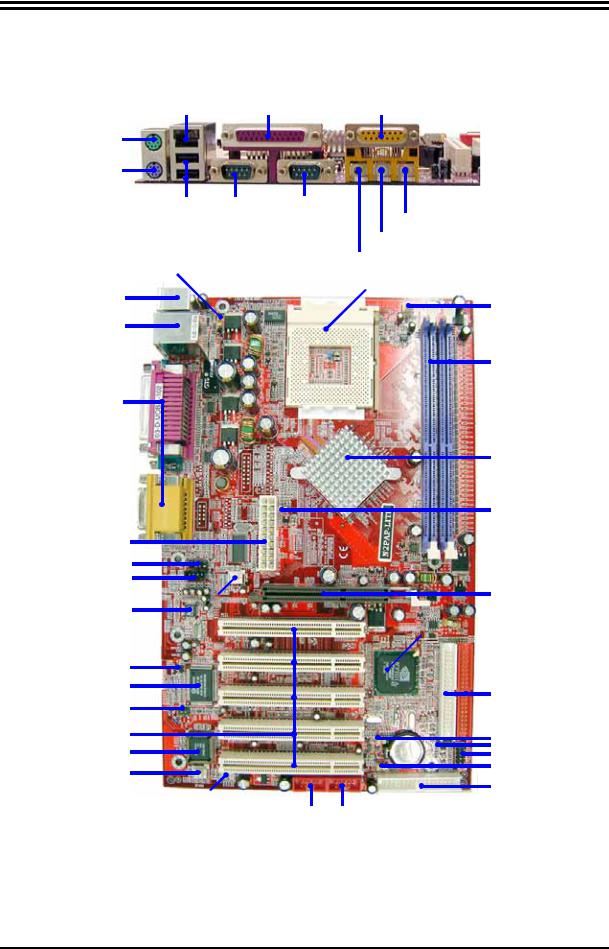
1-4 Layout Diagram & Jumper Setting
LAN |
PRINTER |
GAME/MIDI PORT |
|
PS/2 MOUSE |
|
|
|
|
|
|
|
|
|
|
|
|
|||||
PS/2 KEYBOARD |
|
|
|
|
|
|
|
|
|
|
|
|
||||||
|
|
|
USB COM1 |
COM2A |
|
|
|
|
MIC |
|||||||||
|
|
|
|
|
|
|
||||||||||||
|
|
|
|
|
|
|
|
|
|
|
|
|
|
|
LINE-IN |
|||
|
|
|
|
|
|
|
|
|
|
|
|
|
|
|
||||
K/B Power ON Jumper (JP1) |
|
|
|
|
|
|
|
|
LINE-OUT |
|||||||||
|
|
|
|
|
|
|
|
|||||||||||
|
|
|
|
|
|
|
|
|
|
|
|
|||||||
|
|
|
|
|
|
|
|
|
|
|
|
|
|
|
|
|
CPU Socket |
|
PS2 KB/Mouse Port |
|
|
|
|
|
|
|
|
|
|
||||||||
|
|
|
|
|
|
|
|
|
||||||||||
|
|
|
|
|
|
|
|
|
|
CPU FAN |
|
|||||||
|
|
|
|
|
|
|
|
|
|
|
|
|
|
|
|
|
|
|
|
USB Port/ |
|
|
|
|
|
|
|
|
|
|
|
|
|||||
|
|
|
|
|
|
|
|
|
|
|
|
|
||||||
LAN Connector |
|
|
|
|
|
|
|
|
|
|
|
|
||||||
|
|
|
|
|
|
|
|
|
|
|
|
|
|
|
|
|
DDR DIMM X2 |
|
PC99 Back Panel |
|
|
|
|
|
|
|
|
|
|
|
|
||||||
|
|
|
|
|
|
|
|
|
|
|
|
|
|
|
|
|
nVIDIA nForce2 400 Chip |
|
|
|
|
|
|
|
|
|
|
|
|
|
|
|
|
|
|
(JP2) |
|
|
|
|
|
|
|
|
|
|
|
|
|
|
|
|
|
|
CPU F.S.B. Frequency Selector |
|
ATX Power Connector |
|
|
|
|
|
|
|
|
|
|
|
|
||||||
Front Panel Audio |
|
|
|
|
|
|
|
|
|
|
|
|
||||||
|
CD Audio |
|
|
|
|
|
|
|
|
|
|
|
|
|||||
|
SFAN1 |
|
|
|
|
|
|
|
|
|
|
|
|
AGP 4X/8X Slot |
||||
|
|
|
|
|
|
|
|
|
|
|
|
|||||||
AC97’ Audio Codec |
|
|
|
|
|
|
|
|
|
|
|
|
||||||
|
CIR Connector |
|
|
|
|
|
|
|
|
|
nVIDIA nForce2 MCP Chip |
|||||||
|
|
|
|
|
|
|
|
|
|
|
|
|
||||||
Winbond 83627HF Chip |
|
|
|
|
|
|
|
|
|
|
ATA 133 IDE Conn. |
|||||||
|
|
|
|
|
|
|
|
|
|
|
|
|
|
|
|
|
||
|
IR Connector |
|
|
|
|
|
|
|
|
|
|
|
|
|||||
|
PCI Slot |
|
|
|
|
|
|
|
|
|
|
Clear CMOS (JP3) |
||||||
2MBit Flash ROM BIOS |
|
|
|
|
|
|
|
|
|
|
Speak Connector |
|||||||
|
|
|
|
|
|
|
|
|
|
Front Panel Connector |
||||||||
|
SFAN2 |
|
|
|
|
|
|
|
|
|
USB Power On Jumper |
|||||||
|
|
|
|
|
|
|
|
|
|
(JP4) |
||||||||
|
Wake On LAN |
|
|
|
|
|
|
|
|
|
|
|
|
|
|
|
Floppy Connector |
|
|
|
|
|
|
|
|
|
|
|
|
|
|||||||
|
|
|
|
|
|
|
|
|
|
|
|
|
|
|
|
|
|
|
|
|
|
|
|
|
|
USB Port |
|
|
|
|
|
|
|
|
|||
|
|
|
|
|
|
|
(USB2, USB1) |
|
|
|
|
|
|
|
|
|||
4

Jumpers
Jumper |
Name |
Description |
Page |
JP1 |
Keyboard Power On Enabled/Disabled |
3-pin Block |
P.6 |
JP4 |
USB Wake-Up Enabled/Disabled |
3-pin Block |
P.6 |
JP2 |
CPU Front Side Bus Frequency Selector |
2-pin Block |
P.6 |
JP3 |
CMOS RAM Clear Jumper |
3-pin Block |
P.7 |
Connectors
Connector |
Name |
Description |
Page |
PWR |
ATX Power Connector |
20-pin Block |
P.12 |
KYB |
PS/2 Mouse & PS/2 Keyboard |
6-pin Female |
P.12 |
|
Connector |
|
|
J1 |
USB/LAN Port Connector |
2 x 4-pin/RJ45 Connector |
P.12 |
LPT |
Parallel Port Connector |
25-pin Female |
P.13 |
AUDIO_PORT |
Audio Connector |
3 phone jack Connector |
P.13 |
(Line-OUT/Line-IN/MIC) |
|
|
|
AUDIO_GAME |
Game Port Connector |
15-pin Female Connector |
P.13 |
COM1/COM2A |
Serial Port COM1/2 |
9-pin Connector |
P.13 |
|
Connector |
|
|
FDD |
Floppy Driver Connector |
34-pin Block |
P.13 |
IDE1/IDE2 |
Primary/Secondary IDE |
40-pin Block |
P.14 |
|
Connector |
|
|
Headers
Header |
Name |
Description |
Page |
AUDIO |
Line-Out, MIC Header |
9-pin Block |
P.14 |
USB1/USB2 |
USB Port Headers |
9-pin Block |
P.15 |
HD LED |
IDE activity LED |
2-pin Block |
P.15 |
RESET |
Reset switch lead |
2-pin Block |
P.15 |
SPEAK |
Speaker connector |
4-pin Block |
P.15 |
PWR LED |
Power LED |
2-pin Block |
P.15 |
PWR BTN |
Power switch |
2-pin Block |
P.15 |
WOL |
Wake On-LAN Headers |
3-pin Block |
P.16 |
SFAN1, SFAN2, CPUFAN |
FAN Headers |
3-pin Block |
P.16 |
IR |
IR infrared module Headers |
5-pin Block |
P.16 |
CDIN |
CD Audio-In Headers |
4-pin Block |
P.17 |
Expansion Slot and Socket
Socket/Slot |
Name |
Description |
Page |
ZIF Socket 462 |
CPU Socket |
462-pin PPGA CPU Socket |
P.8 |
DIMM1, DIMM2 |
DDR SDRAM Module |
184-pin DDR SDRAM Module |
P.9 |
|
Socket |
Expansion Socket |
|
PCI1, PCI2, PCI3, |
PCI Slot |
32-bit PCI Local Bus Expansion Slot |
P.10 |
PCI4, PCI5 |
|
|
|
AGP |
AGP 4X/8X Mode Slot |
AGP Expansion Slot |
P.12 |
5
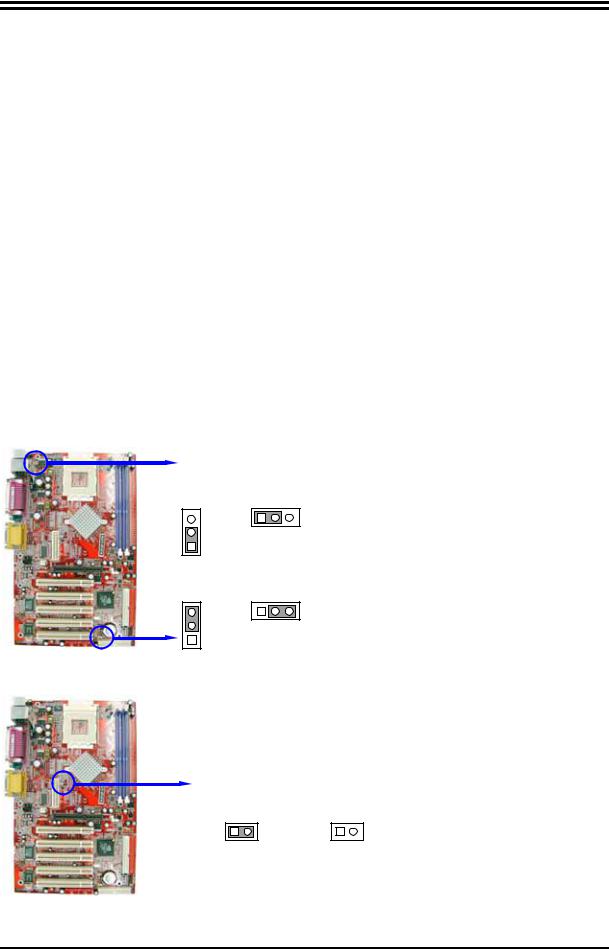
Chapter 2
Hardware Installation
2-1 Hardware installation Steps
When installing the system, make sure to follow steps described in below:
1.Check motherboard setting
2.Install CPU
3.Install memory
4.Install expansion cards
5.Connect ribbon cables, panel wires, and power supply
6.Setup BIOS
7.Install software driver & utility
2-2 Checking Motherboard’s Jumper Setting
(1)Keyboard Power On function Enabled/Disabled: JP1
USB Wake-Up function Enabled/Disabled : JP4
When set as Enabled you can use keyboard to power on the system by password keyin, and use USB device to wake up the system.
JP1
3 JP4
1 3
1
JP1
3 JP4
1 3
1
JP1 |
1-2 closed |
K/B Power On Disabled (Default) |
JP4 |
1-2 closed |
USB Power On Disabled (Default) |
JP1 |
2-3 closed |
K/B Power On Enabled |
JP4 |
2-3 closed |
USB Power On Enabled |
(2)CPU Front Side Bus Frequency Setting (2-pin) : JP2
1 |
2 |
1 |
2 |
JP2 |
|
JP2 |
|
ON : (AUTO) OFF : 100MHz
CPU Front Side Bus Frequency
6
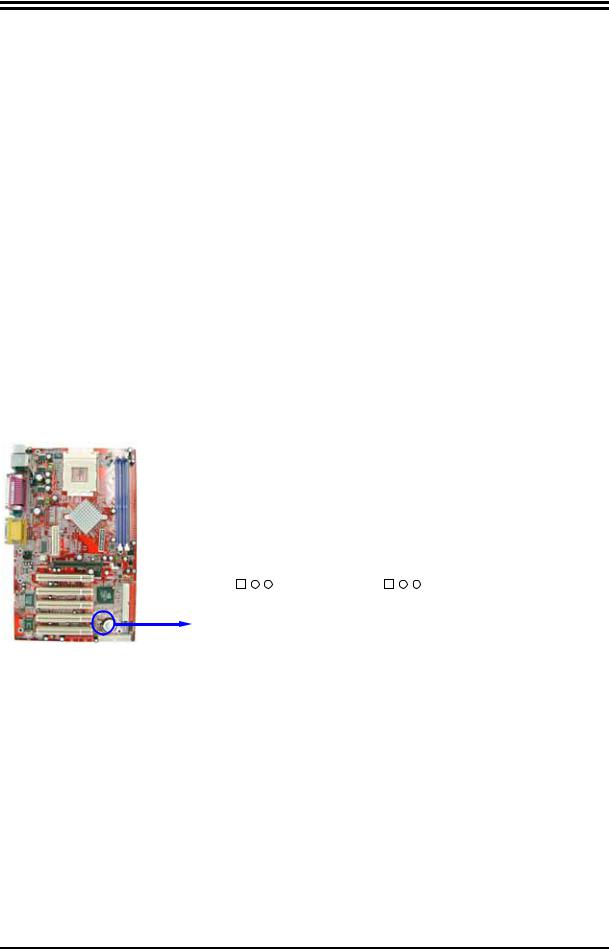
Note: CPU Front Side Bus Frequency also can be changed in BIOS SETUP. Please refer to page 32 “Host Clock at Next Boot Is” selection in Miscellaneous Control menu.
Note: When the overclocking causes system boot failure, you will need to hold the “INS” key and the power on button at the same time until the screen resumes display to the standard default. Otherwise the CMOS will keep the faulty data and the motherboard will not function.
(3)CMOS RAM Clear (3-pin) : JP3
A battery must be used to retain the motherboard configuration in CMOS RAM. Shorting 1-2 pins of JP3 will store the CMOS data.
To clear the CMOS, follow the procedure in below:
1.Turn off the system and unplug the AC power
2.Remove ATX power cable from ATX power connector
3.Locate JP3 and short pins 2-3 for a few seconds
4.Return JP3 to its normal setting by shorting pins 1-2
5.Connect ATX power cable back to ATX power connector
Note: When should CMOS be cleared
1.Troubleshooting
2.Forget password
3.System boot failure after overclocking
1 |
|
3 |
|
1 |
|
|
3 |
|
|
|||
JP3 |
|
|
|
|
JP3 |
|
|
|
|
|
|
|
|
|
|
|
|
|
|
|
|
|
|
||
|
|
|
|
|
|
|
|
|
|
|
||
1-2 closed |
Normal |
2-3 closed |
Clear CMOS |
|||||||||
CMOS RAM Clear Setting
7

2-3 Install CPU
2-3-1 Glossary
Chipset (or core logic) - two or more integrated circuits which control the interfaces between the system processor, RAM, I/O devises, and adapter cards.
Processor Slot/Socket - the slot or socket used to mount the system processor on the motherboard. Slot (AGP, PCI, ISA, RAM) - the slots used to mount adapter cards and system RAM.
AGP - Accelerated Graphics Port - a high speed interface for video cards; runs at 1X (66MHz), 2X (133MHz), 4X (266MHz), or 8X (533MHz).
PCI - Peripheral Component Interconnect - a high speed interface for video cards, sound cards, network interface cards, and modems; runs at 33MHz.
ISA - Industry Standard Architecture - a relatively low speed interface primarily used for sound cards and modems; runs at approx. 8MHz.
Serial Port - a low speed interface typically used for mouse and external modems. Parallel Port - a low speed interface typically used for printers.
PS/2 - a low speed interface used for mouse and keyboards.
USB - Universal Serial Bus - a medium speed interface typically used for mouse, keyboards, scanners, and some digital cameras.
Sound (interface) - the interface between the sound card or integrated sound connectors and speakers, MIC, game controllers, and MIDI sound devices.
LAN (interface) - Local Area Network - the interface to your local area network.
BIOS (Basic Input/Output System) - the program logic used to boot up a computer and establish the relationship between the various components.
Driver - software, which defines the characteristics of a device for use by another device or other software.
Processor - the "central processing unit" (CPU); the principal integrated circuit used for doing the "computing" in "personal computer"
Front Side Bus Frequency - the working frequency of the motherboard, which is generated by the clock generator for CPU, DRAM and PCI BUS.
CPU L2 Cache - the flash memory inside the CPU, normally Athlon CPU has 256K or above, while Duron will have 64K.
2-3-2 About AMD Athlon XP, Athlon & Duron 462-pin CPU
This motherboard supports Socket-A (Socket-462) AMD Athlon/Duron processors.
This motherboard Provides a ZIF Socket-A. The CPU to be used with the motherboard should have a cooling FAN attached to prevent overheating. If this is not the case, then purchase a correct cooling FAN before you turn on your system.
WARNING! Be sure that there is sufficient air circulation across the processor’s heatsink and CPU cooling FAN is working correctly, otherwise it may cause the processor and motherboard overheat and damage, you may install an auxiliary cooling FAN, if necessary.
WARNING! Due to this motherboard provides new function of protecting CPU you must connect the CPU FAN connector on CPUFAN location in order to obtain this feature. Without connection on CPUFAN (or you have connect CPU FAN on SFAN1), the system will shut down immediately to protect both your CPU and motherboard.
8
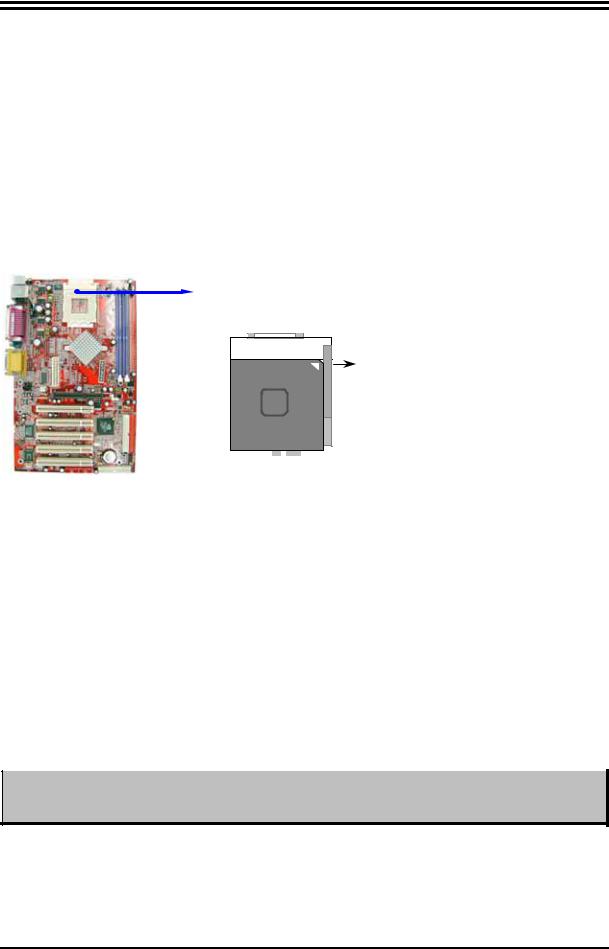
Overheat Protect: Only for Athlon XP series CPU, when the CPU is overheated, system will automatically shut down power supply. You can hear a continue beep sound, the power button will be locked up. You must turn off and turn on the AC power to reset the system. Otherwise, the power button will not function. The other way is to keep pressing the button for a few seconds till the beep sound stops. Then, release the power button and press the power button again to turn on the power supply.
To install a CPU, first turn off your system and remove its cover. Locate the ZIF socket and open it by first pulling the lever sideways away from the socket and lift the lever upward to a 90-degree angle. Insert the CPU with the correct orientation as shown below. The notched corner should be pointed toward the end of the lever. The CPU has corner pin on two of the four corners and the CPU will only fit in the orientation as shown.
Socket 462
Colden Arrow
CPU ZIF Socket-A
When you insert the CPU onto the ZIF socket, no force is required. After inserting, press the lever slightly without any extra force to lock CPU in position.
2-4 Install Memory
This motherboard provides two 184-pin DUAL INLINE MEMORY MODULES (DIMM) sockets for memory expansion from a minimum memory size of 64MB to maximum memory size of 2.0GB DDR SDRAM.
Valid Memory Configurations
Bank |
184-Pin DIMM |
PCS |
Total Memory |
||
Bank 0, 1 |
(DIMM1) |
DDR 266/333/400 |
DDR SDRAM |
X1 |
64MB 1.0GB |
Bank 2, 3 |
(DIMM2) |
DDR 266/333/400 |
DDR SDRAM |
X1 |
64MB 1.0GB |
Total |
System Memory (Max. 2.0GB) |
2 |
64MB 2.0GB |
||
NOTE! Make sure the total installed memory size does not exceeds 2.0GB. Otherwise, the system may hang during startup.
Generally, installing DDR SDRAM modules to the motherboard is very straightforward. Please refer to figure 2-4 for the detail of 184-Pin DDR 266/333/400 DDR SDRAM module and the socket.
9
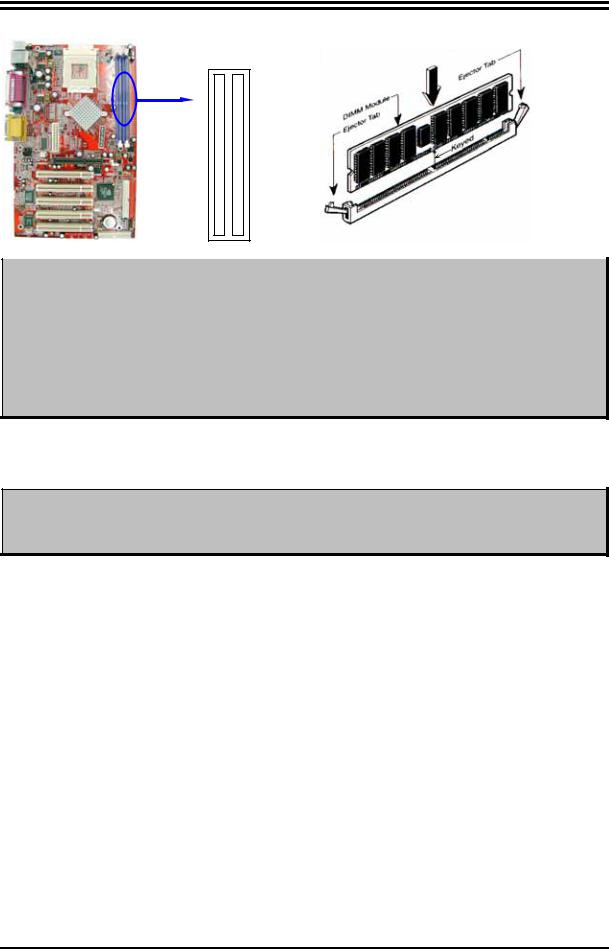
DIMM1 (BANK0+BANK1) |
DIMM2 (BANK2+BANK3) |
Figure 2-4
NOTE! When you install DIMM module fully into the DIMM socket the eject tab should be locked into the DIMM module very firmly and fit into its indention on both sides.
WARNING! For the DDR SDRAM CLOCK setting of 166MHz, use only DDR333 compliant DDR Modules. When this motherboard operates at 133Mhz, most system will not even boot if non-compliant modules are used because of the strict timing issues, if your DDR Modules are not DDR266-compliant, set the DDR SDRAM clock to 100MHz to ensure system stability.
2-5 Expansion Cards
WARNING! Turn off the power when adding or removing expansion cards or other system components. Failing to do so may cause severe damage to both the motherboard and expansion cards.
2-5-1 Procedure For Expansion Card Installation
1.Read the documentation of the expansion card and make any necessary hardware or software setting on the expansion card, such as jumpers, before installing.
2.Remove computer cover and the bracket plate on the slot you intend to use.
3.Align the card’s connectors and press firmly.
4.Secure the card on the slot with the screw you remove above.
5.Replace the computer system’s cover.
6.Set up the BIOS if necessary.
7.Install the necessary software driver of expansion card.
2-5-2 Assigning IRQs For Expansion Card
Some expansion cards need an IRQ to operate. Generally, an IRQ must be exclusively assigned. In a standard design, there are 16 IRQs available, but most of them might already be in use.
10

Standard Interrupt Assignments
IRQ |
Priority |
Standard function |
0 |
N/A |
System Timer |
1 |
N/A |
Keyboard Controller |
2 |
N/A |
Programmable Interrupt |
3 * |
8 |
Communications Port (COM2) |
4 * |
9 |
Communications Port (COM1) |
5 * |
6 |
Sound Card (sometimes LPT2) |
6 * |
11 |
Floppy Disk Controller |
7 * |
7 |
Printer Port (LPT1) |
8 |
N/A |
System CMOS/Real Time Clock |
9 * |
10 |
ACPI Mode when enabled |
10 * |
3 |
IRQ Holder for PCI Steering |
11 * |
2 |
IRQ Holder for PCI Steering |
12 * |
4 |
PS/2 Compatible Mouse Port |
13 |
N/A |
Numeric Data Processor |
14 * |
5 |
Primary IDE Channel |
15 * |
1 |
Secondary IDE Channel |
* These IRQs are usually available for ISA or PCI devices.
2-5-3 Interrupt Request Table For This Motherboard
Interrupt requests are shared as shown in the table below: |
|
|
||
|
|
|
|
|
|
INT A |
INT B |
INT C |
INT D |
PCI slot 1 |
Shared |
|
|
|
PCI slot 2 |
|
Shared |
|
|
PCI slot 3 |
|
|
Shared |
|
PCI slot 4 |
|
|
|
Shared |
PCI slot 5 |
Shared |
|
|
|
AGP slot |
Shared |
|
|
|
AC97/MC97 |
|
|
Shared |
|
Onboard USB |
|
|
|
Shared |
Onboard USB 1 |
|
|
|
Shared |
Onboard USB 2 |
|
|
|
Shared |
IMPORTANT! If using PCI cards on shared slots, make sure that the drivers support “Shared IRQ” or that the cards don’t need IRQ assignments. Conflicts will arise between the two PCI groups and will make the system unstable or cards inoperable.
11
